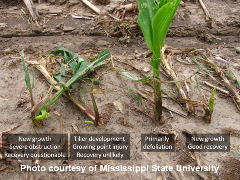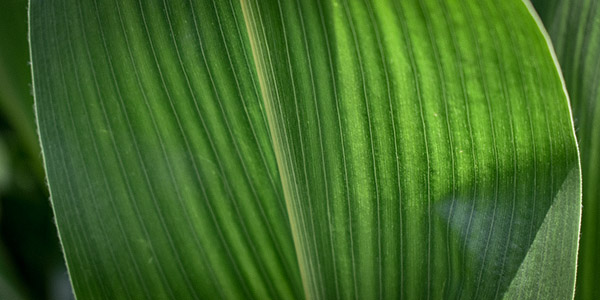AGRONOMICSUPPORT
YOU CAN TAKETO THE FIELD
Early Season Hail Damage
As we begin to receive much anticipated and needed early season rains, the threat of hail-producing thunderstorms increases. As with most early-season problems, evaluation of hail-damaged fields should not be attempted the day after the storm occurs because it can be very difficult to predict survivability of damaged plants by simply looking at the damage itself. Young corn has an amazing ability to recover from early season damage, but patience is required to allow the damaged plants enough time to visibly demonstrate whether they will recover or not.
One thing you can do shortly after the storm, however, is to evaluate the relative condition of the main growing point area of the stalk. The growing point region is important because it is responsible for creating all the leaves and the tassel of a corn plant.
Initially, the growing point is located below ground, but soon elevates above ground beginning at about V5. Slicing a stalk down the middle and looking for the pyramid-shaped upper stalk tissue can identify the vertical position of the growing point. If hail has damaged the growing point or cut off the stalks below the growing point, then those plants should be counted as losses.
 Remember that yield loss in corn is not directly related to the reduction in the number of plants per acre when the damage occurs early in the growing season. The surviving plants that surround a missing plant compensate by increasing their potential kernel numbers or by developing a second ear.
Remember that yield loss in corn is not directly related to the reduction in the number of plants per acre when the damage occurs early in the growing season. The surviving plants that surround a missing plant compensate by increasing their potential kernel numbers or by developing a second ear.
Patience and time are two key factors that influence your ability to assess the recovery potential of a damaged field for the purposes of making a replant decision. Within three to five days following a damaging storm, fresh leaf growth will be visible from within the whorl of surviving plants. Plants whose growing point regions have been severely injured will show little evidence of recovery from the whorl. Warm weather during these three to five days following the damage will speed up both the recovery of the survivors and deterioration of the fatally wounded plants and will immensely slow down during cooler periods.
Sources and Additional Information:
Download a copy of this technical bulletin here: Early Season Hail Damaged Corn





Technical Team Agronomist